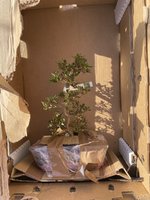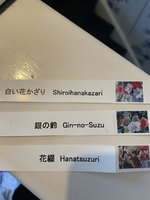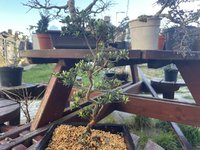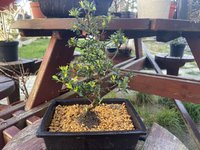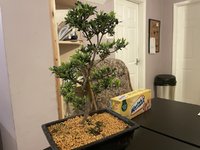Hello all! I just wanted to show off another Satsuki I've just added to the collection. This one is 'Senbazuru', and according to the seller it has one of the longest flowering periods. It looks very healthy, and I can't wait to see that new growth and flowers being pushed out in a few months time! I'm quite concerned about any late frosts in England here, so I think I'll be quite cautious with this one and keep it in the cold frame overnight.
You are using an out of date browser. It may not display this or other websites correctly.
You should upgrade or use an alternative browser.
You should upgrade or use an alternative browser.
Glaucus
Chumono
Yes, this cultivar has a mutated flower, like Chojuho. This causes the flower to be partially leaf-partially flower. This makes it change colour from green to yellowish-white. And this is why the flower lasts much longer.
The Japanese call it misome-sho and it is found as a mutation in several species of evergreen azaleas. This mutation was first described 300 years ago. The interesting thing is that Senbazuru is a recent and deliberate breeding effort to create a white version of Chojuho. Scientists identified the actual gene responsible for this mutation. It is a recessive loss of function mutation. So it took two generations of breeding to obtain Senbazuru.
As for frost, if it suddenly experiences more cold weather than the place where you got it from (where it might have been in a greenhouse), then indeed better protect it.
However, next year it should be ok outside all winter unless you get crazy weather. Make sure it doesn't wake up too early and is then hit by -2C frost. That will kill the new growth (and the new growth only).
I am keeping everything outside myself, until I see growth being pushed. Then I will shelter them again. Winter has been very mild. But now we have sunny clear sky late winter days, so it is warm during the day, mild frost during the night.
A healthy satsuki in a pot can deal with this no problem. It is what they experience in Japan as well.
Of course, you want to be cautious, observant, and confident in what you do when you get a new tree.
The Japanese call it misome-sho and it is found as a mutation in several species of evergreen azaleas. This mutation was first described 300 years ago. The interesting thing is that Senbazuru is a recent and deliberate breeding effort to create a white version of Chojuho. Scientists identified the actual gene responsible for this mutation. It is a recessive loss of function mutation. So it took two generations of breeding to obtain Senbazuru.
As for frost, if it suddenly experiences more cold weather than the place where you got it from (where it might have been in a greenhouse), then indeed better protect it.
However, next year it should be ok outside all winter unless you get crazy weather. Make sure it doesn't wake up too early and is then hit by -2C frost. That will kill the new growth (and the new growth only).
I am keeping everything outside myself, until I see growth being pushed. Then I will shelter them again. Winter has been very mild. But now we have sunny clear sky late winter days, so it is warm during the day, mild frost during the night.
A healthy satsuki in a pot can deal with this no problem. It is what they experience in Japan as well.
Of course, you want to be cautious, observant, and confident in what you do when you get a new tree.
Always so knowledgeable about Satsuki! That's actually some very interesting history, and I can't wait to see it in bloom. Breeding satsuki is such an interesting topic, can I ask where you learnt about this? I'd love to learn more, and I'd really like to learn more about plant genetics in university. Another question I have is, if I took a cutting from anywhere on this Senbazuru, would it produce the same flowers? I know that with some other cultivars, you have to propagate them from branches that produce radial flowers, but if it's only one flower type then how would this work?Yes, this cultivar has a mutated flower, like Chojuho. This causes the flower to be partially leaf-partially flower. This makes it change colour from green to yellowish-white. And this is why the flower lasts much longer.
The Japanese call it misome-sho and it is found as a mutation in several species of evergreen azaleas. This mutation was first described 300 years ago. The interesting thing is that Senbazuru is a recent and deliberate breeding effort to create a white version of Chojuho. Scientists identified the actual gene responsible for this mutation. It is a recessive loss of function mutation. So it took two generations of breeding to obtain Senbazuru.
As for frost, if it suddenly experiences more cold weather than the place where you got it from (where it might have been in a greenhouse), then indeed better protect it.
However, next year it should be ok outside all winter unless you get crazy weather. Make sure it doesn't wake up too early and is then hit by -2C frost. That will kill the new growth (and the new growth only).
I am keeping everything outside myself, until I see growth being pushed. Then I will shelter them again. Winter has been very mild. But now we have sunny clear sky late winter days, so it is warm during the day, mild frost during the night.
A healthy satsuki in a pot can deal with this no problem. It is what they experience in Japan as well.
Of course, you want to be cautious, observant, and confident in what you do when you get a new tree.
Glaucus
Chumono
You can read the research paper here:
and here:
Of course it is very technical language intended for peers. This is how I know what type of mutation it is.
As for the breeding of Senbazuru, it is one of a few satsuki cultivar where the parents are unnamed but the grandparents are named. The parentage is found here:
Since the mutation is recessive, the parents of Senbazuru were very likely carriers of the mutant gene, but had normal flowers themselves. As is described in the research paper, where the F2 (second) generation had the mutant flower 25% of the time.
I have never heard of this type of mutation reverting. Narrow petal cultivar like Kinsai have a tendency to revert to normal flowers. So it seems that this mutation is very to extremely stable.
The research paper says that a retrotransposon has inserted itself in the AP3/DEF gene, interrupting and breaking the genetic code of the gene, causing a loss of function, resulting in the mutant flowers.. Theoretically, a retrotransposon can 'jump' out again, restore the function of the gene, and result in normal flowers once more. But apparently this retrotransposon doesn't jump. At least, I have never heard of it doing so or seen a picture of a Senbazuru or Chojuho with a branch that had normal flowers.
The papers don't comment on the stability or why this retrotransposon doesn't jump. They do call the mutation 'stable'. So I wouldn't worry at all. It behaves differently from Kinsai.
This info is mostly a curiosity and doesn't matter if you just grow it for bonsai or flowers. However, if you want to do breeding for this long-lasting flower mutation, this info means that if you cross two of these mutant flowers, all offspring will have the mutant long-lasting flowers. However, if you cross them with a normal azalea, all will have normal flowers. But all will also be carriers of the mutant gene. If you cross the F1 to obtain F2, there will be 25% odds of the long-lasting flower appearing. And when crossing back a F1 seedling to a mutant flower type, you will have 50% odds the long-lasting flower mutation occurring.
So for those who want to breed long-lasting flower cultivars, I would recommend crossing either Chojuho or Senbazuru with your favourite normal azalea. Grow these seedlings which would be the F1 (first) generation, all without the mutant long-lasting flower. Then cross these F1 seedlings back to Senbazuru. Senbazuru is preferrable to Chojuho, because Senbazuru is already a hybrid. Chojuho is likely a species form of Rhododendron indicum. So crossing with Senbazuru will likely result in more diverse offspring. There are no purple or multicolour or variegated long-lasting flower cultivars.
and here:
Of course it is very technical language intended for peers. This is how I know what type of mutation it is.
As for the breeding of Senbazuru, it is one of a few satsuki cultivar where the parents are unnamed but the grandparents are named. The parentage is found here:
Since the mutation is recessive, the parents of Senbazuru were very likely carriers of the mutant gene, but had normal flowers themselves. As is described in the research paper, where the F2 (second) generation had the mutant flower 25% of the time.
I have never heard of this type of mutation reverting. Narrow petal cultivar like Kinsai have a tendency to revert to normal flowers. So it seems that this mutation is very to extremely stable.
The research paper says that a retrotransposon has inserted itself in the AP3/DEF gene, interrupting and breaking the genetic code of the gene, causing a loss of function, resulting in the mutant flowers.. Theoretically, a retrotransposon can 'jump' out again, restore the function of the gene, and result in normal flowers once more. But apparently this retrotransposon doesn't jump. At least, I have never heard of it doing so or seen a picture of a Senbazuru or Chojuho with a branch that had normal flowers.
The papers don't comment on the stability or why this retrotransposon doesn't jump. They do call the mutation 'stable'. So I wouldn't worry at all. It behaves differently from Kinsai.
This info is mostly a curiosity and doesn't matter if you just grow it for bonsai or flowers. However, if you want to do breeding for this long-lasting flower mutation, this info means that if you cross two of these mutant flowers, all offspring will have the mutant long-lasting flowers. However, if you cross them with a normal azalea, all will have normal flowers. But all will also be carriers of the mutant gene. If you cross the F1 to obtain F2, there will be 25% odds of the long-lasting flower appearing. And when crossing back a F1 seedling to a mutant flower type, you will have 50% odds the long-lasting flower mutation occurring.
So for those who want to breed long-lasting flower cultivars, I would recommend crossing either Chojuho or Senbazuru with your favourite normal azalea. Grow these seedlings which would be the F1 (first) generation, all without the mutant long-lasting flower. Then cross these F1 seedlings back to Senbazuru. Senbazuru is preferrable to Chojuho, because Senbazuru is already a hybrid. Chojuho is likely a species form of Rhododendron indicum. So crossing with Senbazuru will likely result in more diverse offspring. There are no purple or multicolour or variegated long-lasting flower cultivars.
Even more Satsuki's! This time I've bought three new cultivars: Shiroihanakazari, Gin-no-Suzu and Hanatsuzuri. They all seem to be in very good condition with some new growth being put out, with many flower buds. I'm not sure what I'll do this year - I think I'll enjoy their flowers and strip the flower buds next year to focus on development. Unfortunately I didn't think ahead before removing the tags off them, so I have no idea which is which haha. Guess I'll have to wait until they flower.
Attachments
Glaucus
Chumono
Nice pickups, but why would you remove the tags, lol?
My guess is, the middle 4893 is Hanatsuzuri.
4984 definitely is not Hanatsuzuri. So my wilder guess would be that one is Shiroihanakazari.
So 4892 the one on the right is then Gin no Suzu.
Hanatsuzuri is one of my favourites.
Flowers will make it easy.
My guess is, the middle 4893 is Hanatsuzuri.
4984 definitely is not Hanatsuzuri. So my wilder guess would be that one is Shiroihanakazari.
So 4892 the one on the right is then Gin no Suzu.
Hanatsuzuri is one of my favourites.
Flowers will make it easy.
I have a little hook which I like to hang the tags of all my collected Satsuki’s on for a bit of decoration, but I completely forgot that since they all come from the same nursery and are trained in the same way that they’d be pretty much identical.Nice pickups, but why would you remove the tags, lol?
My guess is, the middle 4893 is Hanatsuzuri.
4984 definitely is not Hanatsuzuri. So my wilder guess would be that one is Shiroihanakazari.
So 4892 the one on the right is then Gin no Suzu.
Hanatsuzuri is one of my favourites.
Flowers will make it easy.
I’m very excited for the flowers of these, especially Gin-no-Suzu. The flowers have a bit of a different shape (which I’m sure there’s a term for) that I haven’t seen before. I really like the patterns on Hanatsuzuri too. Out of curiosity, what gave you some clues about which one is which? Is it the foliage shape and size etc.?
JudyB
Queen of the Nuts
I have a Senbazuru that I got from Bill Valavanis. They are hard to find here! I love the muted coloration of the blooms, and they are prolific. They are not quite as vigorous as some of my Satsuki, so prune with that in mind. Here is mine a couple years ago, it has had a pot change since then, to a better shape and size for it. Congrats on your acquisition!
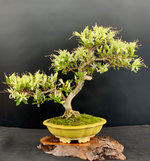



That’s absolutely beautiful! It really makes me wish that we had access to more Satsuki material in the UK. It doesn’t seem like there’s many cultivars or younger material for sale that you can find here. You just have to get lucky and have a look at bonsai nurseries/independent sellers frequently.I have a Senbazuru that I got from Bill Valavanis. They are hard to find here! I love the muted coloration of the blooms, and they are prolific. They are not quite as vigorous as some of my Satsuki, so prune with that in mind. Here is mine a couple years ago, it has had a pot change since then, to a better shape and size for it. Congrats on your acquisition!
View attachment 475754View attachment 475755
I can’t wait for my Senbazuru to bloom, those flowers are absolutely amazing. I wasn’t even aware of the mutated flower until Glaucus mentioned it, so I’m quite excited now haha.
JudyB
Queen of the Nuts
I’m sometimes jealous of the things that are easier to get over there on your side, I feel so lucky to have found one here. I looked for several years…That’s absolutely beautiful! It really makes me wish that we had access to more Satsuki material in the UK. It doesn’t seem like there’s many cultivars or younger material for sale that you can find here. You just have to get lucky and have a look at bonsai nurseries/independent sellers frequently.
I can’t wait for my Senbazuru to bloom, those flowers are absolutely amazing. I wasn’t even aware of the mutated flower until Glaucus mentioned it, so I’m quite excited now
Glaucus
Chumono
Better to just always keep labels on satsuki cultivar. For many reasons, but also you might have way more in 10 years time than you would guess now.I have a little hook which I like to hang the tags of all my collected Satsuki’s on for a bit of decoration, but I completely forgot that since they all come from the same nursery and are trained in the same way that they’d be pretty much identical.
I’m very excited for the flowers of these, especially Gin-no-Suzu. The flowers have a bit of a different shape (which I’m sure there’s a term for) that I haven’t seen before. I really like the patterns on Hanatsuzuri too. Out of curiosity, what gave you some clues about which one is which? Is it the foliage shape and size etc.?
It is kinda a guess, it is not so clear. But the leaves being smaller, darker and more pointy makes me guess Hanatsuzuri on that one. Since you removed the labels, I just had to try to guess.
SgtPilko
Mame
Nice! I think all the UK nurseries just got their annual shipments over from Japan so now is a good time to buy if you want first pick 
This is a great excuse to buy even more trees haha. I'm planning a trip to Greenwoods soon when they put out their stock, as I went there last year and they had quite a nice selection of different cultivars of Satsuki. I picked up a Mibu-no-Hana last year, and I'd love to see if I can find a Tateyama-no-Mai, Kinsai or Hanabin!Nice! I think all the UK nurseries just got their annual shipments over from Japan so now is a good time to buy if you want first pick
So all of the ones I have bought have put on a bit of growth in around 10 days, which is lovely to see. I was wondering, is slip potting this azalea into quite a substantially larger pot a good idea? I'm not quite comfortable with doing a full repot on the newly acquired azaleas (I was planning to do them next year) so I thought that I might slip pot them instead. My aim is to try and get quite a lot of growth out of my azaleas this year to thicken them up a bit so I thought I'd do this by putting them in large pots.
If so, should I simply tease the roots around the edges a little bit when I do slip pot it? And if so, will I need to keep it in a bit of shade for a few weeks like my other repots? I'm not sure if slip potting is a good idea in the first place though, as I'm not sure how recently it was repotted and if the soil would degrade quite badly until I next repot it (which would be around 2025/2026?)
If so, should I simply tease the roots around the edges a little bit when I do slip pot it? And if so, will I need to keep it in a bit of shade for a few weeks like my other repots? I'm not sure if slip potting is a good idea in the first place though, as I'm not sure how recently it was repotted and if the soil would degrade quite badly until I next repot it (which would be around 2025/2026?)
Attachments
Glaucus
Chumono
You should do a repot when the kanuma is old. No reason to repot before that. This pot also seems quite large. Is it potbound? Or is there still kanuma space for the roots to explore into?
It's tied in so I'm not able to get a good look at the roots, but there's no signs of it being pot bound. I'm pretty sure it would've been repotted either last year or potentially earlier this year - probably the former. I think I'll keep it in the same pot for this year, but I was thinking that if it had a lot more soil to grow into the growth would be a bit faster? This is what I've seen when ground-growing species like Alder, but I've never tried it with an azalea before.You should do a repot when the kanuma is old. No reason to repot before that. This pot also seems quite large. Is it potbound? Or is there still kanuma space for the roots to explore into?
Glaucus
Chumono
Root growth is not proportional to the size of the pot. If there is no space for new roots, then yes that will slow down root growth. But giving it 2 or 3x the space it needs won't speed up root growth. For azaleas, I have had mixed results with overpotting. Sometimes it turns out great. In other times, I feel that the pot stays too moist because the plant doesn't absorb all the water in the soil in between rain/waterings. This will be more of an issue when you use peat.
A healthy plant that is growign well that is overpotted seems to be fine. But if growth is slow and it is overpotted, that seems to be an issue. Kanuma drains a lot better so the wetness isn't that much of an issue.
Putting it in full ground is not the same as putting it in a pot that is very large.
In kanuma, it should be repotted every 3 to 4 years. There are many videos on Youtube of Japanese repotting satsuki bonsai that are in kanuma, which shows the general procedure.
Deepseadiver also has some threads on repotting satsuki azaleas into kanuma.
A healthy plant that is growign well that is overpotted seems to be fine. But if growth is slow and it is overpotted, that seems to be an issue. Kanuma drains a lot better so the wetness isn't that much of an issue.
Putting it in full ground is not the same as putting it in a pot that is very large.
In kanuma, it should be repotted every 3 to 4 years. There are many videos on Youtube of Japanese repotting satsuki bonsai that are in kanuma, which shows the general procedure.
Deepseadiver also has some threads on repotting satsuki azaleas into kanuma.
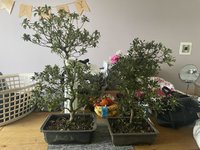
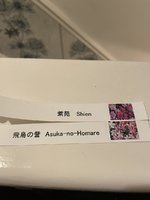
Two more Satsuki's join the collection! On the left, Asuka-no-Homare. On the right, Shien.
@Glaucus any interesting background information on these two cultivars?
These two are my biggest so far by quite a margin, and I'm quite excited to get working on them. I was going to pick up 'Reiko' instead of 'Shien', but unfortunately the Reiko was a bit out of my price range. Nevertheless, Shien seems to look quite nice and the tree looks dense. These were picked up from Greenwoods Bonsai Nursery in Nottingham.
I'm taking a trip to All Things Bonsai in Sheffield next week too, where I may pick up another azalea depending on what I can find. There's also a seller I've found which sells 'Komei' and 'Dai-seiko' which I may pick up soon enough.
Glaucus
Chumono
Asuka no Homare is another sport of Asuka. I belive the leaves are more rounded. I have a larger plant of this variety now as well, but it hasn't flowered yet.
So far, my plant looks quite healthy and the leaves present well in winter.
'Shien', I have no special insights in.
So far, my plant looks quite healthy and the leaves present well in winter.
'Shien', I have no special insights in.
Similar threads
- Replies
- 24
- Views
- 2K



